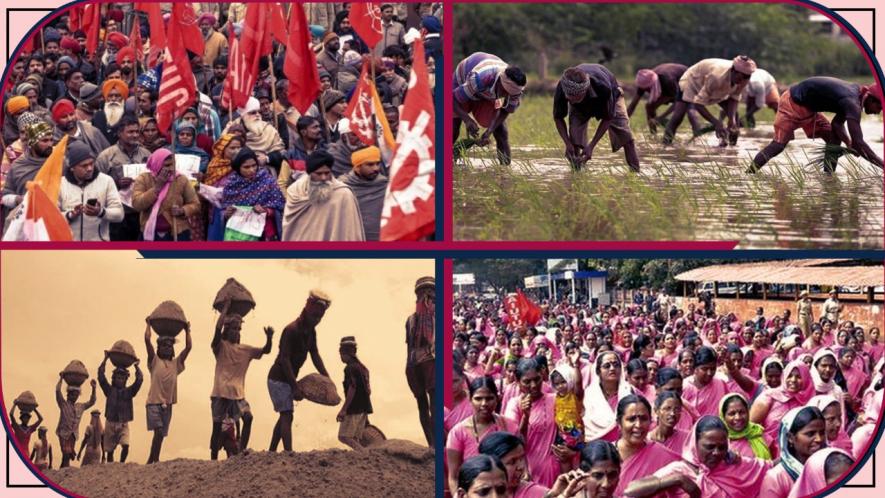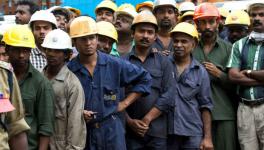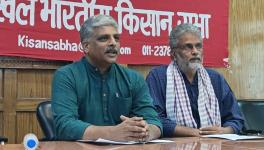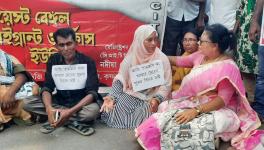2022: India’s Workers and Peasants Fight Back – and Fight on

In India, the year that has just passed, started with hope but ended with anger and discontent. Hope, because it was thought that with the pandemic finally dwindling, the economy would revive and so would jobs and incomes. The mainstream media talked of a V-shaped recovery, government again started talking of a $5 trillion economy (whatever that means). Although there was no reason to do so, but working people, desperate after two years of extreme hardship, hoped against hope. The victory of the farmers’ movement in forcing the government to back down on the three agricultural laws also boosted the morale – perhaps, the government was finally beginning to listen to the people. However, this dream broke down in short order.
Not only has the jobs crisis worsened but unbridled price rise over several months, including for staples like wheat and cooking oil, has drastically eroded the already meagre incomes of working people, the self-employed and farmers. The economy is stagnating, investment is not happening, exports are down, imports are up, the rupee is getting devalued, indirect taxes are rising (driven by onerous excise duties on petroleum products) – and inequality is rising fast. This was not what was hoped for.
Although the working class and peasantry, as indeed various other sections of society, had continued their fight for better economic conditions through the pandemic ravaged two years, this turn of events led to deep and widespread anger. This was aggravated by the attempts of the Bharatiya Janata Party (BJP) government to further tighten the screws on the people by cutting funds for various welfare programmes like ICDS (Integrated Child Development Scheme) and MGNREGA (Mahatma Gandhi National Rural Employment Guarantee), of increasing contractualisation leading to intense job insecurity, and the relentless push to privatise everything -- from historical monuments and railway stations to profit making public sector units, hospitals and schools.
All over the country, there emerged struggles for immediate local demands – teachers and school cooks demanding payment of back wages, anganwadi workers demanding increase in honoraria, municipal contract workers demanding regularisation, steel workers demanding scrapping of privatisation, farmers demanding better prices or roll back of land acquisition, tribals fighting for their customary forest and land rights, and so on.
Historic 2-Day Strike
These strands of anger coalesced and merged into a massive, historic two-day general strike on March 28-29, 2022. It was one of the biggest strikes Independent India has ever seen taking into its sweep diverse industrial sectors as well as large sections of the unorganised and informal sector.
Read Also: Why is India going on a General Strike on March 28-29?
What made it so impactful that even the international media was forced to take note of it, was the fact that very large number of farmers and agricultural labourers too joined in the protests on these two days. Steel, coal, port & dock, transport (including road, rail and water), financial sectors, telecom, electricity, sales representatives, and lakhs of scheme workers (those working in government schemes like ICDS, National Health Mission, etc) took part in the strike or joined in protests across the country. The call for the strike was jointly given by the 10 central trade unions (barring the one affiliated to the Rashtriya Swayamsevak Sangh or RSS/BJP) and also the Samyukta Kisan Morcha (SKM), a joint platform of over 500 farmers’ rganisations that had spearheaded the victorious farmers’ movement.
The demands of the striking and protesting workers and peasants included raising the minimum wage to Rs.26,000 per month, grant of Rs.7,500 per month to non-tax paying families to tide over the pandemic induced slow-down, end to contractualisation of jobs, roll back of disinvestment policies, guarantee of statutory minimum support price (MSP) for a range of agricultural crops, scrapping of the Electricity Amendment Bill, expansion and universalisation of the Public Distribution System, etc.
The strike was notable for large scale participation of workers from the private organised sector in Karnataka, Telangana, Tamil Nadu, Maharashtra and other states on both days. It saw huge participation of scheme workers, plantation sector workers, and diverse unorganised sector workers like construction, beedi, head load workers, street vendors, domestic workers, IT employees, road transport workers etc. Railway contract workers, particularly goods sheds workers, safai karmacharis, bedroll workers, track maintenance workers etc. participated in the demonstrations on March 28-29 in several states.
Sectoral Struggles and Strikes
Subsequently, the country saw a rolling wave of struggles across various sectors, which had been struggling in earlier years too and carried on further.
At the call of All India Federation of Anganwadi Workers & Helpers, thousands of anganwadi employees participated in a three-day-long Anganwadi Adhikar Mahapadav in front of Parliament in New Delhi during July 26-28 2022 against the anti-worker, anti-people, anti-scheme workers policies of the Central government. Independent as well as joint strikes of ASHA (Accredited Social Health Activists) workers were held in Haryana, Maharashtra, Madhya Pradesh and Uttarakhand etc demanding additional remuneration achieved partial success.
On August 8, 2022, more than one million electricity employees, engineers and pensioners came out on the streets across the whole country to protest against the autocratic move of the Central government to introduce the Electricity Amendment Bill 2022 in Parliament. The lightning strike/work-boycott action and stiff opposition within Parliament compelled the government to refer the Bill for examination by a Parliamentary Standing Committee. Meanwhile, protests have been ongoing in various Union Territories where the Central government is pushing for electricity privatisation.
On August 10, 2022, postal employees resorted toan unprecedented strike in all 23 circles across the country at the call of their national federation, NFPE, and GDS (Gramin Dak Sewak) union.
Steel workers of the Vizag Steel Plant continued their valiant struggle against privatisation, getting massive public support. The Andhra Pradesh government led by the YSR Congress, which had earlier signed a memorandum of understanding with South Korea’s POSCO to hand over land of Vizag Steel Plant, was also forced to support the struggle against its privatisation.
Also, coal workers conducted campaigns and protests against legislative action by the government to promote commercial mining through private sector, after opening it up to foreign direct investment earlier. The telecom employees of BSNL, under the leadership of various unions acting jointly, carried on protest agitations in various forms against the discriminatory policies of the government against state-run telecom service provider.
Defence production employees organised numerous protest programmes against the government’s moves to dismantle the ordnance factories network for privatisation through the corporatisation route and the promulgation of Essential Defence Service Ordinance prohibiting strikes in the defence sector and empowering the government to prohibit strikes in sectors having link with defence sector production activities which was later enacted as Essential Defence Services or EDS Act.
About two lakh medical and sales representatives (SPEs) of the pharmaceuticals industry observed a one-day countrywide strike on January 19, 2022 in pursuance of their 16-point demands.
In the transport sector, struggles by road transport workers against fuel price hikes and the new Motor Vehicle Act continued. Water transport workers organised massive joint campaign and agitation against the National Monetisation Pipeline (NMP) which seeks to privatise all major ports, and the Major Port Authority Act. Struggles also took place at the port level by workers and their unions against hiving off the port hospital through the public-private partnership route.
The cement sector, too, saw a series of struggles in Madhya Pradesh, Himachal and Rajasthan. In MP, the President of the Centre of Indian Trade Unions in JS Cement was recently reportedly killed by the management-sponsored goons and the mass of the workers’ counter response to that compelled the administration to arrest some senior management officials, and at the same time the company was also compelled to pay substantial compensation.
The employees of both Central and state governments, at the initiative of their respective confederations and federations, also staged a number of protest agitations on their demands and also organised solidarity programmes in support of peasants’ struggles.
Gig workers in the transport sector (Uber, Ola) staged a massive agitation in West Bengal and compelled the employers and the state government to come forward for negotiation and settlement. Also, workers of Swiggy organised a successful agitation on their demands and against attacks on their working conditions in West Bengal, Tamil Nadu and Jharkhand at the initiative of a CITU union.
Besides these, there were important and militant struggles and strikes in private sector industries in several states like Karnataka, Tamil Nadu, Telangana, Maharashtra
Agitation/demonstrations against the retrograde “Agnipath scheme” of the government were also initiated while supporting the numerous spontaneous upsurge of protest in various parts of the country.
Farmers’ Protests
Under the aegis of SKM, farmers continued to fight for a variety of local issues while also focusing on the central demands for a statutory MSP guarantee, sacking of a central minister whose son is the prime accused in the Lakhimpur Kheri mowing down of farmers, etc.
In June, farmers joined anti-Agnipath protests across the country. The scheme for short-term recruitment in the Armed Forces was heavily criticised for betraying the aspirations of lakhs who were looking to join the Armed Forces as a career. The peasantry, especially in some Indian states, has deep ties with the armed forces and consequently this scheme was strongly opposed.
In November, on the second anniversary of the farmers’ movement (which started on November 26, 2020) massive protests were held in all state capitals jointly by farmers’ organisations and supported by trade unions and other peoples’ organisations.
Farmers have been fighting sustained battles against land acquisition (as in Azamgarh, UP), better prices for produce and clearance of dues (sugarcane farmers in western UP), charging of metered electricity rates from farmers in UP, and many other such issues that damage the economic viability of farming. Protests were also held against shortage of fertilisers in several states.
Mazdoor Kisan Sangharsh Rally 2 on April 5, 2023
A massive Workers’ Peasants Convention was held on September 5, 2022 at New Delhi in which over 6,000 workers-peasants-agri-workers from all states participated. This was organised by CITU along with the All India Kisan Sabha and AIAWU, the agricultural workers union. This represented another big step forward in building the already growing unity between industrial workers, farmers and agricultural workers for rejection of the anti-people policies of the BJP government and presenting an alternative set of pro-people policies,
The convention gave a call for a massive Mazdoor Kisan Sangharsh Rally on April 5, 2023 during the budget session of Parliament to be preceded by a series of campaign-agitations. Preparations for this are already underway. By all accounts, the rally is expected to see a never before mobilisation of the labouring classes of India. The new
year of 2023, therefore, promises to be a year of determined and sweeping struggles, epitomised by this Sangharsh Rally.
Get the latest reports & analysis with people's perspective on Protests, movements & deep analytical videos, discussions of the current affairs in your Telegram app. Subscribe to NewsClick's Telegram channel & get Real-Time updates on stories, as they get published on our website.
























